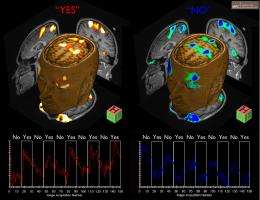September 22, 2010 report
Vegetative state patients may soon be able to communicate

(PhysOrg.com) -- Researchers from Cambridge University in the UK have been able to communicate with brain-injured patients in "locked states" commonly referred to as persistent vegetative states (PVS). They predict such patients will soon be able to communicate and perhaps even move themselves around in motorized wheelchairs.
Neuroscientist Dr. Adrian Owen and colleagues used electroencephalography (EEG) monitors connected to 128 electrodes in a cap placed on the heads of brain injured patients, and were able to understand responses from them. Own thinks a similar system connected to a computer will be able to decode messages from their brains and allow them to communicate via a voice synthesizer and even control a motorized wheelchair. These systems could be available within a decade.
Dr. Owen used functional magnetic resonance imaging (fMRI) brain scans to prove that one PVS victim could understand queries and give “yes” or “no” answers to simple questions. The 29-year-old male patient had suffered brain damage in a car accident in 2003, and had been in a coma for two years before entering a persistent vegetative state. He appeared to be awake and blinked occasionally, but otherwise showed no signs of awareness.
The team used the fMRI scanner to measure the patient’s brain response while asking him questions. Brain signals associated with “yes” and “no” are complex and quite similar, and to overcome this problem the researchers asked the patient to imagine playing tennis for “yes” and walking through his home for “no”. Tennis movements activate regions at the top of the brain associated with spatial activities, while moving around the home is a navigational task that activates areas in the base of the brain. Using this technique the patient was able to correctly answer six test questions.
The team has now shown that similar responses could be achieved using EEG monitors, which measure electrical activity in the brain. EEG has the advantages of being much cheaper, smaller, and more portable than fMRI, which uses magnetic fields and radio waves to detect electrical pulses in the brain. EEG also gives results much more quickly than fMRI, making a conversation possible.
Dr. Owen said “we have seen something that is quite extraordinary” and that we now have a moral and ethical obligation to find ways to help patients in persistent vegetative states to communicate. The communication will be via yes/no questions, but he said “you can get a long way with yes/no questions.”
The research findings suggest about 20 percent of PVS sufferers could be able to communicate, and this may raise questions about switching off life support systems for such patients.
Dr. Owen and several members of team will soon be transferring to research posts at the University of Western Ontario in Canada, where they will receive a grant worth around 20 million US dollars to continue the research.
More information:
-- Monti MM, Vanhaudenhuyse A, Coleman MR, Boly M, Pickard JD, Tshibanda L, Owen AM, Laureys S (2010), “Willful modulation of brain activity in disorders of consciousness.” N Engl J Med 362(7):579-89
-- Owen AM, Coleman MR, Davis MH, Boly M, Laureys S, Pickard JD (2006), “Detecting awareness in the vegetative state” Science 313:1402
© 2010 PhysOrg.com
















